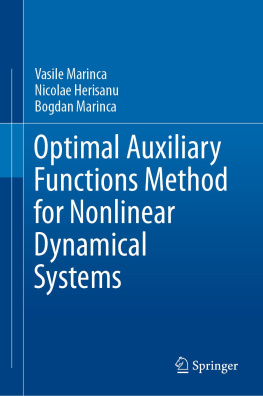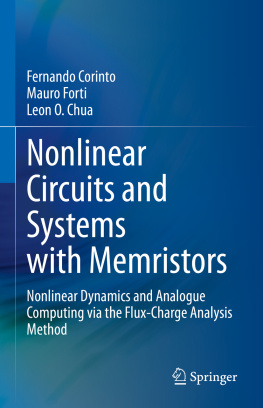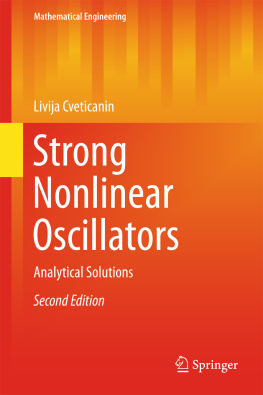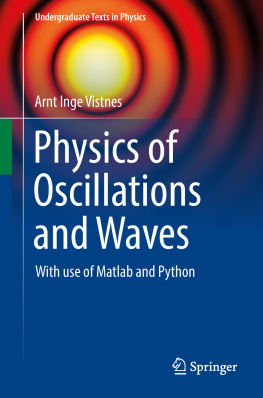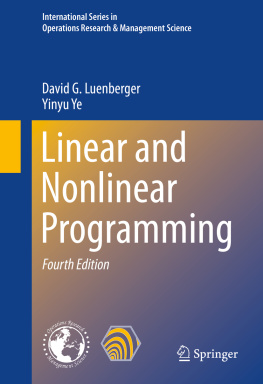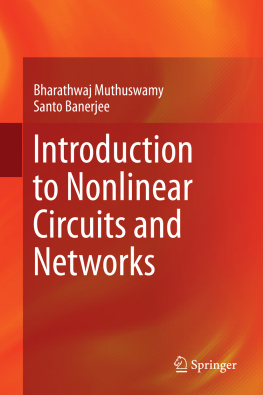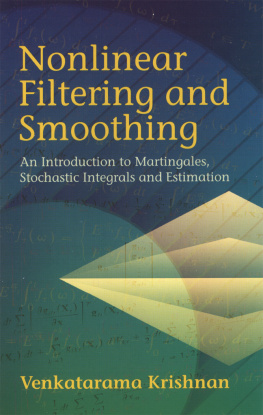Nekorkin - Introduction to Nonlinear Oscillations
Here you can read online Nekorkin - Introduction to Nonlinear Oscillations full text of the book (entire story) in english for free. Download pdf and epub, get meaning, cover and reviews about this ebook. year: 2015, publisher: John Wiley & Sons, Incorporated, genre: Computer. Description of the work, (preface) as well as reviews are available. Best literature library LitArk.com created for fans of good reading and offers a wide selection of genres:
Romance novel
Science fiction
Adventure
Detective
Science
History
Home and family
Prose
Art
Politics
Computer
Non-fiction
Religion
Business
Children
Humor
Choose a favorite category and find really read worthwhile books. Enjoy immersion in the world of imagination, feel the emotions of the characters or learn something new for yourself, make an fascinating discovery.
- Book:Introduction to Nonlinear Oscillations
- Author:
- Publisher:John Wiley & Sons, Incorporated
- Genre:
- Year:2015
- Rating:5 / 5
- Favourites:Add to favourites
- Your mark:
- 100
- 1
- 2
- 3
- 4
- 5
Introduction to Nonlinear Oscillations: summary, description and annotation
We offer to read an annotation, description, summary or preface (depends on what the author of the book "Introduction to Nonlinear Oscillations" wrote himself). If you haven't found the necessary information about the book — write in the comments, we will try to find it.
Nekorkin: author's other books
Who wrote Introduction to Nonlinear Oscillations? Find out the surname, the name of the author of the book and a list of all author's works by series.
Introduction to Nonlinear Oscillations — read online for free the complete book (whole text) full work
Below is the text of the book, divided by pages. System saving the place of the last page read, allows you to conveniently read the book "Introduction to Nonlinear Oscillations" online for free, without having to search again every time where you left off. Put a bookmark, and you can go to the page where you finished reading at any time.
Font size:
Interval:
Bookmark:

- Couallier, V., Gerville-Rache, L., Huber, C., Limnios, N., Mesbah, M. (eds.)
- Statistical Models and Methods for Reliability and Survival Analysis
- 2014
- Print ISBN: 978-1-848-21619-8; also available in electronic formats
- Kirillov, O.N., Pelinovsky, D.E. (eds.)
- Nonlinear Physical Systems
- Spectral Analysis, Stability and Bifurcations
- 2013
- Print ISBN: 978-1-848-21420-0; also available in electronic formats
- Brzdov, V., Bowler, D.R.
- Atomistic Computer Simulations
- A Practical Guide
- 2013
- Print ISBN: 978-3-527-41069-9; also available in electronic formats ISBN: 978-3-527-67181-6
- Nayfeh, A.H.
- The Method of Normal Forms
- 2 Edition
- 2011
- Print ISBN: 978-3-527-41097-2; also available in electronic formats ISBN: 978-3-527-63580-1
Author
Vladimir I. Nekorkin
Institute of Applied Physics of the Russian Academy of Sciences
46 Uljanov str.
603950 Nizhny Novgorod
Russia
Cover
iStock 5401380, AndrzejStajer
All books published by Wiley-VCH are carefully produced. Nevertheless, authors, editors, and publisher do not warrant the information contained in these books, including this book, to be free of errors. Readers are advised to keep in mind that statements, data, illustrations, procedural details or other items may inadvertently be inaccurate.
Library of Congress Card No.: applied for
British Library Cataloguing-in-Publication Data
A catalogue record for this book is available from the British Library.
Bibliographic information published by the Deutsche Nationalbibliothek The Deutsche Nationalbibliothek lists this publication in the Deutsche Nationalbibliografie; detailed bibliographic data are available on the Internet at .
2015 by Higher Education Press. All rights reserved. Published by Wiley-VCH Verlag GmbH & Co. KGaA, Boschstr. 12, 69469 Weinheim, Germany, under exclusive license granted by Higher Education Press Limited Company for all media and languages excluding Chinese and throughout the world excluding Mainland China, and with non-exclusive license for electronic versions in Mainland China.
All rights reserved (including those of translation into other languages). No part of this book may be reproduced in any form by photoprinting, microfilm, or any other means nor transmitted or translated into a machine language without written permission from the publishers. Registered names, trademarks, etc. used in this book, even when not specifically marked as such, are not to be considered unprotected by law.
Print ISBN: 978-3-527-41330-0
ePDF ISBN: 978-3-527-68543-1
ePub ISBN: 978-3-527-68542-4
Mobi ISBN: 978-3-527-68539-4
Printing and Binding Markono Print Media Pte Ltd, Singapore
At the foundation of this course material are lectures on a general course in the theory of oscillations, which were taught by the author for more than 20 years at the Faculty of Radiophysics at Nizhny Novgorod State University (NNSU).
The aim of the course was not only to express fundamental ideas and methods of the theory of oscillations as a science of evolutionary processes, but also to teach the audience the methods and techniques of solving specific (practical) problems.
The key role in forming this lecture course is played by qualitative methods of the theory of dynamical systems and methods of the theory of bifurcations, which follow the tradition of Nizhny Novgorod school of nonlinear oscillations. These methods are even used when solving simple problems, where, in principle, their use is not necessary. Such a way of presenting the following material allows us, first of all, to reveal the essence and fundamental principles of the methods, and, secondly, for the reader to develop the skills necessary to put them to use, which appears to be important for the transition to studying more complex problems.
The book is constructed in the form of lectures in accordance with the syllabus of the course Theory of Oscillations for the Faculty of Radiophysics at NNSU. Yet, the content of nearly every lecture in this book is expanded further than it is usually presented during the reading of a formal lecture. This makes it possible for the reader to gain additional knowledge on the subject. At the end of each lecture, there are test questions and problems for revision and independent study.
This text could also prove useful to undergraduate and graduate students specializing in the field of nonlinear dynamics, information systems, control theory, biophysics, and so on.
The author is grateful to the colleagues at the department of Theory of Oscillations and Automated Control for many useful discussions on the topics of this text and to the colleagues from the department of Nonlinear Dynamics at the Institute of Applied Physics of the Russian Academy of Sciences.
Vladimir I. Nekorkin
Nizhny Novgorod
October 2014
Introduction to the Theory of Oscillations
Oscillatory processes and systems are so widely distributed in nature, technology, and society that we frequently encounter them in our everyday life and can, apparently, formulate their basic properties without difficulty. Indeed, when we hear about fluctuations in temperature, exchange rates, voltage, a pendulum, the water level, and so on, we understand that it is in relation to processes in time or space, which have varying degrees of repetition and return to their original or similar states. Moreover, these base properties of the processes do not depend on the nature of systems and Can, therefore, be described and studied from just the point of view of a general interdisciplinary approach. This is exactly the approach that the theory of oscillations explores, the subject of which are the oscillatory phenomena and the processes in systems of different nature. The theory of oscillations gets its oscillatory properties from the analysis of the corresponding models. As a result of such an analysis, a connection between the parameters of the model and its oscillatory properties is established.
The theory of oscillations is both an applied and fundamental science. The applied character of the theory of oscillations is determined by its multiple applications in physics, mechanics, automated control, radio engineering and electronics, instrumentation, and so on. In these spheres of science, a large amount of research of different systems and phenomena was carried out, using the methods of the theory of oscillations. Furthermore, new technical directions have arisen on the basis of the theory of oscillations, namely, vibrational engineering and vibrational diagnostics, biomechanics, and so on. The fundamental characteristic of the theory of oscillations is based on the studied models themselves. They are the so-called dynamical systems, with the help of which one can describe any determinate evolution in time or in time and space. It is exactly the study of dynamical systems that allowed the theory of oscillations to introduce the concepts and conditions, develop the methods, and achieve the results that exert a large influence on other natural sciences. Here, we only mention the linearized stability theory, the concept of self-sustained oscillations and resonance, bifurcation theory, chaotic oscillations, and so on.
Font size:
Interval:
Bookmark:
Similar books «Introduction to Nonlinear Oscillations»
Look at similar books to Introduction to Nonlinear Oscillations. We have selected literature similar in name and meaning in the hope of providing readers with more options to find new, interesting, not yet read works.
Discussion, reviews of the book Introduction to Nonlinear Oscillations and just readers' own opinions. Leave your comments, write what you think about the work, its meaning or the main characters. Specify what exactly you liked and what you didn't like, and why you think so.




